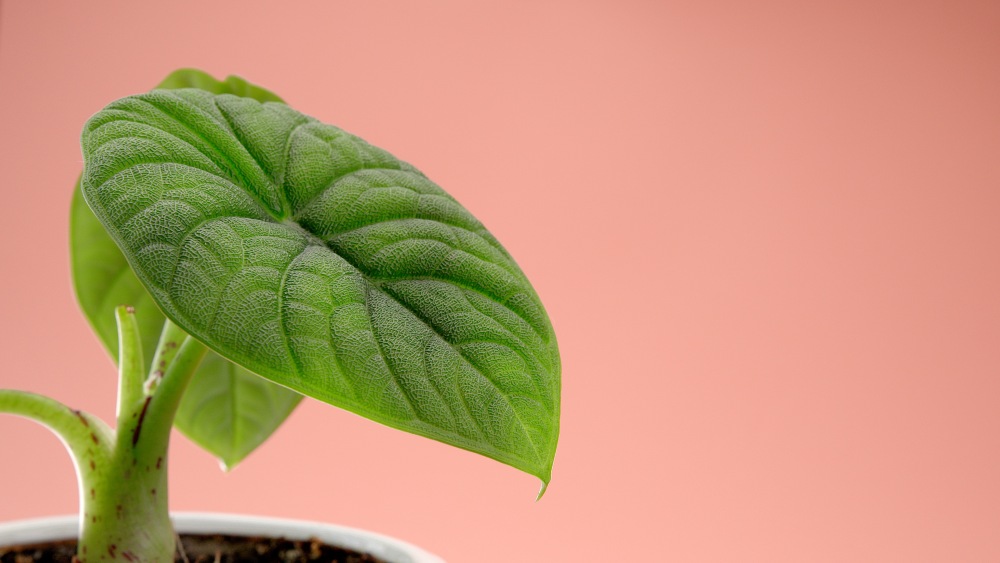
Alocasia Melo, also known as the African Mask Plant, is a stunning houseplant that features dark green, almost black, heart-shaped leaves with striking, prominent veins. Its dramatic appearance makes it a favorite among plant collectors, and while it can be a bit more challenging to care for compared to other houseplants, the reward is well worth the effort. If you're thinking about adding this beauty to your collection, here’s everything you need to know about caring for Alocasia Melo.
Alocasia Melo thrives in bright, indirect light. Too much direct sunlight can scorch its delicate foliage, while too little light can cause the plant to become leggy and lose its vibrant color. Aim to place your Alocasia Melo near a window where it can receive plenty of filtered light. East or west-facing windows are ideal, as they provide bright light without the harsh midday sun. If you don’t have access to natural light, you can supplement with a grow light to ensure the plant gets the energy it needs.
Alocasia Melo prefers consistently moist soil, but doesn’t like to sit in water. Overwatering or letting the plant sit in waterlogged soil can lead to root rot. To maintain the right balance, water the plant thoroughly when the top inch or so of soil feels dry. Be sure to check your plants soil’s moisture level before watering to avoid overwatering. In the winter months, the plant's growth slows down, so you may need to water less frequently.
Ensure that your pot has proper drainage to allow excess water to drain, and never let the plant sit in a saucer of water. If your leaves start turning yellow or brown, it could be a sign of overwatering or poor drainage.
Alocasia Melo is native to tropical climates, so it prefers warm temperatures between 65°F and 80°F (18°C to 27°C). Avoid placing it in areas with drafts, such as near windows or air conditioning vents, as cold temperatures can stress the plant.
As a tropical plant, Alocasia Melo also thrives in high humidity. It prefers humidity levels of at least 60%. If you live in a dry climate, consider placing a humidifier near the plant or placing it on a humidity tray filled with water and pebbles to increase moisture around the leaves. You can also mist the leaves occasionally to help boost humidity, but be careful not to overdo it, as too much moisture can lead to fungal issues.
Alocasia Melo prefers a well-draining, airy potting mix. A good potting mix for this plant is one that retains moisture but also drains well, such as a mix designed for tropical plants or a combination of potting soil, perlite, and orchid bark. This will allow the roots to stay moist without becoming waterlogged.
When choosing a pot, make sure it has drainage holes to prevent excess water from accumulating at the bottom. Alocasia Melo’s roots are sensitive to waterlogged conditions, so proper drainage is crucial for its health. Repot the plant every 1-2 years, or when it outgrows its current pot, preferably in the spring when the plant is actively growing.
Alocasia Melo is a relatively heavy feeder, especially during the growing season (spring and summer). You can fertilize your plant once a month with a balanced, water-soluble fertilizer diluted to half strength. Avoid over-fertilizing, as this can lead to nutrient imbalances and damage to the roots.
In the fall and winter, the plant’s growth slows down, and it doesn’t need as much fertilizer. During this time, you can reduce fertilization to once every 6-8 weeks or stop altogether.
Alocasia Melo is a low-maintenance plant, but regular pruning can help keep it looking tidy and encourage new growth. Trim off any dead or yellowing leaves to keep the plant healthy. You can also cut back any leggy or overgrown stems to maintain a compact shape.
The plant’s stunning foliage can sometimes get dusty, so it’s a good idea to gently wipe the leaves with a damp cloth every few weeks to keep them clean and free from dust. This will also help the plant breathe better and absorb more light.
If you want to propagate your Alocasia Melo, the most effective method is through division. During the spring or summer, when the plant is actively growing, carefully remove the plant from its pot and divide the rhizomes (the underground stems) into smaller sections. Each section should have at least one healthy stem and root system. Replant each division into its own pot with fresh, well-draining soil. Keep your newly potted divisions in a warm, humid environment until they establish roots and begin to grow.
No, Alocasia Melo is toxic to pets. it contains calcium oxalate crystals, which can cause irritation to the mouth, throat, and digestive system if ingested. If you suspect that your pet/s have ingested any part of the plant, contact a veterinarian immediately.
To keep your pets safe, place the Alocasia Melo in an area that is out of their reach, such as on a high shelf or in a room that your pets cannot access.